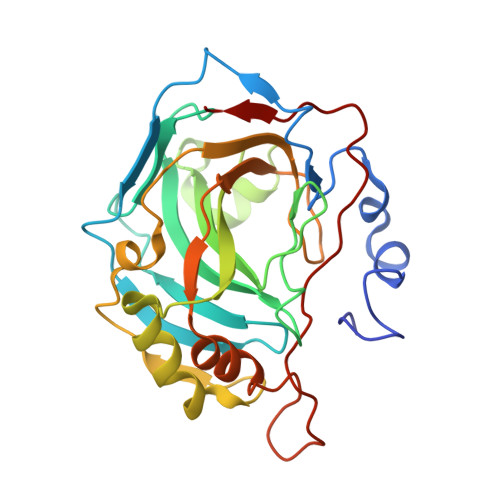Dissecting the Inhibition Mechanism of Cytosolic versus Transmembrane Carbonic Anhydrases by ESR
Ciani, L., Cecchi, A., Temperini, C., Supuran, C.T., Ristori, S.(2009) J Phys Chem B 113: 13998-14005
- PubMed: 19778001
- DOI: https://doi.org/10.1021/jp906593c
- Primary Citation of Related Structures:
3EFT - PubMed Abstract:
Spin-labeled sulfonamides incorporating TEMPO moieties showed efficient activity as inhibitors of the metalloenzyme carbonic anhydrase (CA, EC 4.2.1.1) and, in particular, of the physiologically relevant isoenzymes hCA II, hCA IX, and hCA XIV. Here we report a detailed analysis of this class of inhibitors by means of ESR and X-ray crystallography, in comparison with inhibition tests against all mammalian CA isoforms, CA I-XIV. Local dynamics and structure were manifested in the ESR signal through modulation of internal magnetic anisotropies. Analysis and fitting of the ESR spectra of several spin-labeled sulfonamides with isoforms CA II (cytosolic), CA IX (catalytic domain and full length transmembrane, tumor-associated isoform) and CA XIV (transmembrane isozyme) provided information about polarity and dynamics of specific microenvironments sensed by the nitroxyl group within the active site cavity of these isozymes. The comparison of ESR and crystallographic data of hCA II complexed with one of these inhibitors constitutes a useful tool for the understanding of molecular hindrance and ordering within the enzyme active site, and provides theoretical bases to use these inhibitors for imaging purposes of hypoxic tumors overexpressing the transmembrane isozyme CA IX. Combining the sulfonamide zinc-binding group with the TEMPO moiety thus allowed to dissect the selective inhibition mechanism of different cytosolic and transmembrane carbonic anhydrases.
- Dipartimento di Chimica and CSGI, Universita degli Studi di Firenze, Via della Lastruccia 3, I-50019 Sesto Fiorentino, Firenze, Italy.
Organizational Affiliation:



















